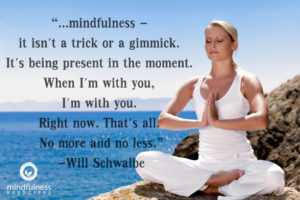Since Mindfulness is something that you can start at any time, it is just a matter of finding time or making sure that you consciously think about incorporating it into your daily routine.
You have to remember that you are walking around with so many thoughts swirling around in your head at any given moment in time that you can feel as if you are unfocused, in a fog, overwhelmed and your mind never having a chance to truly rest.
Mindfulness will help to unclutter and clear your mind, calm your brain and allow it to settle down for a spell.
Have you ever picked up a snow globe and shook the snow until the entire globe becomes so filled that you can barely see the object inside? That is what is going on inside your mind.
Once you start practicing Mindfulness, it will be as if the snow has settled at the bottom of the globe and you can think and see more clearly.
To get you started practicing Mindfulness, completely use these simple exercises to get a jumpstart and overall feel for what Mindfulness is and how it can help you:
- Choose something to focus your attention on
- How will you focus: using your visual, auditory, or tactile senses
- Focus “on purpose”
- How are you going to stay focused in the present moment?
- How does it feel not to be “judgmental?”
- Write what your definition of Mindfulness means to you
Let’s break each of these down to discuss the technique for each step.
Choose something to focus your attention on. By focusing your attention you are choosing a goal you wish to achieve by using Mindfulness. Are you taking a walk? Are you focusing on each step you take? Are you a runner? Are listening to each breath you take? In doing tasks such as these, you are focusing your attention on that task and that task alone. You don’t let your mind wander but instead return your attention to the task over and over again.
How will you focus: using your visual, auditory, or tactile senses? You can use Mindfulness in all areas of your life and surroundings. We pass up so many beautiful moments by listening to all the noise inside our head and not fully appreciating the beauty of any given moment. Before you start, decide what your intention is. Use your eyes to observe the color of the sky, water, buildings, etc. Notice everything about the sky, the clouds, etc. Listen intently to trains in the distance or jets overhead. Are they carrying passengers to a far off destination with family and/or friends? What do those sounds mean to you? Are you making something with your hands? Are you feeling every brushstroke, every knit stitch, etc.? What do you hope to accomplish?
Focus “On Purpose.” By focusing intently you are making sure that you don’t let your mind wander. That is why it is important to identify your intent before you begin. Notice what is happening the moment and acknowledging, but letting go, any distractions. Try to remain aware without changing anything. Observe and take in any and all observations. When you become aware, you can eventually change unwanted patterns.
How are you going to stay focused in the present moment? The world we live in is filled with distractions. We have computers, tablets, iPads, cell phones which are all meant to create and fill our lives with noise. We are so distracted these days that we aren’t even aware of how much the “noise” has taken over our lives. When you practice mindfulness, you are getting rid of the noise. You are paying attention to your thoughts, your feelings, your physical body sensations and surroundings. It will be hard for some people to let go of these distractions but once you do, you will wonder why you didn’t set these items aside for longer periods of time.
How does it feel not be judgmental? Without distractions, we can allow ourselves to set our intention to pay attention. When you allow yourself to focus on one thing, you notice everything about the moment and the object of your intention. You will be in a state where you become non-judgmental. Your mind is not cluttered and you are open to feeling sensations that you might not have felt in a while. You are not being distracted by other thoughts, feelings or physical limitations.
Write what your definition of Mindfulness means to you. After you practice Mindfulness, write down what happened. What does it mean to you? What did you notice? You don’t have to start practicing Mindfulness for an hour a day. Start out slow. Gradually build up your Mindfulness practice a little at a time. Write down your observations each time so you can look back and reflect on where you began and where you are now.



